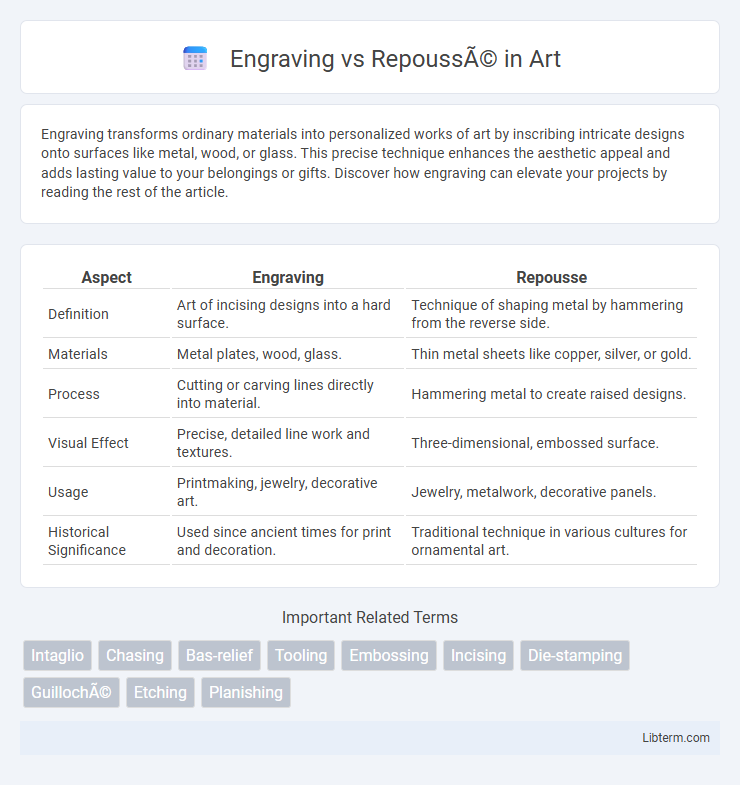Engraving transforms ordinary materials into personalized works of art by inscribing intricate designs onto surfaces like metal, wood, or glass. This precise technique enhances the aesthetic appeal and adds lasting value to your belongings or gifts. Discover how engraving can elevate your projects by reading the rest of the article.
Table of Comparison
| Aspect | Engraving | Repousse |
|---|---|---|
| Definition | Art of incising designs into a hard surface. | Technique of shaping metal by hammering from the reverse side. |
| Materials | Metal plates, wood, glass. | Thin metal sheets like copper, silver, or gold. |
| Process | Cutting or carving lines directly into material. | Hammering metal to create raised designs. |
| Visual Effect | Precise, detailed line work and textures. | Three-dimensional, embossed surface. |
| Usage | Printmaking, jewelry, decorative art. | Jewelry, metalwork, decorative panels. |
| Historical Significance | Used since ancient times for print and decoration. | Traditional technique in various cultures for ornamental art. |
Understanding Engraving and Repoussé
Engraving involves incising designs directly into a hard surface, typically metal, using sharp tools to create precise, detailed patterns or text. Repousse is a metalworking technique where the artist shapes malleable metal from the reverse side to form raised designs or reliefs on the front, often complemented by chasing for detailing. Understanding the distinction highlights engraving's focus on surface cuts and line work, whereas repousse emphasizes three-dimensional sculptural effects through metal shaping.
Historical Origins of Both Techniques
Engraving traces its origins to ancient civilizations such as Mesopotamia and Egypt, where artisans meticulously incised designs onto metal, stone, and bone for decorative and communicative purposes. Repousse emerged in parallel, with early examples found in Bronze Age artifacts across regions like the Mediterranean and Asia, characterized by hammering metal from the reverse side to create raised reliefs. Both techniques have evolved through centuries, influencing artistic expression and craftsmanship in diverse cultures worldwide.
Tools and Materials Required
Engraving requires precise tools such as burins or gravers, often made from hardened steel, to carve intricate designs into metal surfaces like copper, silver, or gold. Repousse involves softer malleable metals like copper, brass, or silver sheets and relies on specialized hammers, punches, and stakes to shape the metal from the reverse side, creating raised relief designs. Both techniques demand careful selection of metals and hand tools suited for either subtractive carving or additive shaping processes.
The Engraving Process Explained
The engraving process involves incising designs directly onto metal surfaces using specialized tools such as burins or gravers, creating precise and detailed lines. This subtractive technique removes material to form intricate patterns or text, commonly applied in jewelry, watches, and decorative art. Engraving allows for high control over depth and texture, distinguishing it from repousse, which shapes metal by hammering from the reverse side.
The Repoussé Technique Detailed
The repousse technique involves shaping malleable metal from the reverse side to create a raised design on the front, using specialized hammers and punches. This method allows artisans to achieve intricate, three-dimensional patterns with depth and texture that are difficult to replicate with engraving, which cuts into the metal surface. Historically prominent in metalworking arts, repousse is favored for decorative armor, jewelry, and sculptures due to its ability to form detailed relief without compromising the metal's structural integrity.
Visual Effects: Differences in Appearance
Engraving creates precise, sharp lines and intricate details carved directly into the metal surface, producing a clean, etched look with deep shadows and high contrast. Repousse involves hammering the metal from the reverse side to raise a design in relief, resulting in a three-dimensional, textured appearance with smooth curves and varying depth. The visual effect of engraving emphasizes fine detail and linear patterns, while repousse highlights volume, form, and sculptural qualities.
Artistic Applications in Modern Design
Engraving offers precise, intricate detailing suitable for jewelry, metalwork, and personalized gifts, emphasizing fine line work and texture depth. Repousse, by shaping metal from the reverse side, creates bold, three-dimensional reliefs ideal for sculptural art, architectural panels, and decorative objects. Modern design leverages engraving for subtle embellishments and repousse for dynamic, tactile surfaces, balancing fine craftsmanship with expressive form.
Comparing Durability and Longevity
Engraving involves cutting or carving into the surface of a metal, creating sharp, precise lines that remain clear and resistant to wear over time, making it highly durable for long-term use. Repousse shapes metal by hammering from the reverse side to form a raised design, which can be more susceptible to deformation and damage due to its embossed nature, potentially reducing its longevity under heavy wear. While both techniques preserve artwork on metal, engraving typically offers superior resistance to deterioration, ensuring longer-lasting detail retention.
Cost and Time Investment Analysis
Engraving typically demands less time and lower material costs as it involves incising designs directly onto a surface, making it suitable for detailed, small-scale projects. Repousse requires more extensive labor and higher costs due to the process of hammering metal from the reverse side to create raised patterns, often necessitating specialized tools and skills. Time investment in repousse is significantly higher because of the multiple stages involved, including annealing and finishing, which increases overall production expenses compared to engraving.
Choosing the Right Technique for Your Project
Engraving involves incising designs directly into a hard surface, ideal for detailed, precise artwork on metals like silver or gold, making it perfect for jewelry or fine decorative items. Repousse shapes metal by hammering from the reverse side to create raised relief designs, suitable for larger, textured pieces such as decorative panels or sculptures. Choosing the right technique depends on the desired detail, material thickness, and project scale, with engraving offering fine line work and repousse providing three-dimensional depth.
Engraving Infographic

 libterm.com
libterm.com